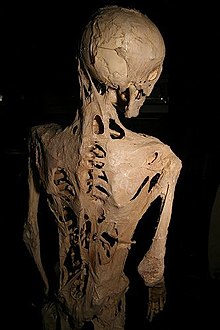fibrodysplasia ossificans progressiva
Jump to navigation
Jump to search
English
[edit]Etymology
[edit]| PIE word |
|---|
| *h₃ésth₁ |

From English fibrodysplasia, and borrowed from New Latin ossificans + Latin prōgressīvā, literally “abnormal development of fibrous tissue with ossification that is progressive”:
- Fibrodysplasia is derived from fibro- (prefix meaning ‘fibre; fibrous’) (from Latin fibra (“fibre; filament”), ultimately from Proto-Indo-European *bʰeyd- (“to split”)) + dysplasia (“abnormal development of cells or tissue”) (from dys- (prefix meaning ‘abnormal; disease’) + -plasia (suffix meaning ‘formation; growth’)).
- Ossificans is from Latin ossīs (a plural form of ossum (“bone”), ultimately from Proto-Indo-European *h₃ésth₁ (“bone”)) + -ficāns (the present active participle of -ficō (suffix forming chiefly causative or factitive verbs)).
- Prōgressīvā is the ablative feminine singular of prōgressīvus (“progressive”), from prōgressus (“advanced, proceeded; developed, progressed”) (the perfect active participle of prōgredior (“to advance, proceed; (figurative) to develop, progress”), from prō- (prefix denoting a forward direction) + gradior (“to step; to walk; to advance”) (ultimately from Proto-Indo-European *gʰredʰ- (“to go; to walk”))) + -īvus (suffix forming adjectives).
The disease was originally termed myositis ossificans progressiva in 1868.[1] The use of fibrodysplasia in place of myositis was suggested by K. H. Bauer and W. Bode in 1940,[2] and adopted by the American medical geneticist Victor A. McKusick (1921–2008) in his work Heritable Disorders of Connective Tissue (1956).[3]
Pronunciation
[edit]- (Received Pronunciation) IPA(key): /ˌfaɪbɹəʊdɪsˈpleɪzɪə ɒˈsɪfɪkɑːnz pɹəˈɡɹɛsɪvə/, /-ˈpleɪʒə-/
- (General American) IPA(key): /ˌfaɪbɹoʊdɪsˈpleɪʒ(i)ə ɒˈsɪfɪkænz pɹəˈɡɹɛsɪvə/, /-ˈpleɪziə-/, /-pɹoʊ-/
Audio (General American): (file) - Hyphenation: fi‧bro‧dys‧plas‧ia os‧si‧fi‧cans pro‧gress‧i‧va
Noun
[edit]fibrodysplasia ossificans progressiva (uncountable)
- (medical genetics) A very rare, disabling genetic disorder of the connective tissue in which fibrous tissue (including ligaments, muscles, and tendons) ossifies (“transforms into bone”) when damaged.
- Synonyms: (abbreviation) FOP, Münchmeyer disease, (obsolete) myositis ossificans progressiva, stone man syndrome
- 1956, Victor A[lmon] McKusick, “Concluding Comments”, in Heritable Disorders of Connective Tissue, St. Louis, Mo.: The C. V. Mosby Company, →OCLC, pages 194–195:
- The cardinal manifestations of fibrodysplasia ossificans progressiva are microdactyly and progressive ossification of fascia, [aponeuroses], and other fibrous structures related to muscles.
- 2006 April 23, Eileen M. Shore [et al.], “A Recurrent Mutation in the BMP Type I Receptor ACVR1 Causes Inherited and Sporadic Fibrodysplasia Ossificans Progressiva”, in Nature Genetics, volume 38, New York, N.Y.: Nature Portfolio, published 1 May 2006, , →ISSN, →OCLC, abstract, page 525:
- Fibrodysplasia ossificans progressiva (FOP) is a rare autosomal dominant disorder of skeletal malformations and progressive extraskeletal ossification. We mapped FOP to chromosome 2q23-24 by linkage analysis and identified an identical heterozygous mutation (617G → A; R206H) in the glycine-serine (GS) activation domain of ACVR1, a BMP type I receptor, in all affected individuals examined.
- 2007 June 18, Ginia Bellafante, “TV review: ‘Heartland’: Doctor, give me the news, and sew me up pretty”, in The New York Times[1], New York, N.Y.: The New York Times Company, →ISSN, →OCLC, archived from the original on 2021-01-26:
- This year that show [Grey's Anatomy] featured a story about a patient with fibrodysplasia ossificans progressiva, a disorder in which damaged muscles and connective tissue turn to bone, forming, essentially, a second skeleton.
- 2022 July 7, Alex Pope, “Hemel Hempstead Mother’s Funding Plea for Daughter’s Rare Disease”, in BBC News[2], archived from the original on 2023-12-11:
- A mother of a one-year-old girl with an illness that turns muscle into bone has urged the government to do more to help research into rare conditions. Lexi Robins, of Hemel Hempstead has the very rare condition Fibrodysplasia Ossificans Progressiva (FOP).
Translations
[edit]genetic disorder in which fibrous tissue ossifies when damaged
References
[edit]- ^ By the German physician Theodor von Dusch (1824–1890): see Victor A[lmon] McKusick (1956) “Concluding Comments”, in Heritable Disorders of Connective Tissue, St. Louis, Mo.: The C. V. Mosby Company, →OCLC, page 185.
- ^ K. H. Bauer, W. Bode (1940) “Erbpathologie der Stützgewebe beim Menschen [Hereditary Pathology of the Supporting Tissues in Humans]”, in Günther Just, editor, Erbbiologie und Erbpathologie körperlicher Zustände und Funktionen [Hereditary Biology and Hereditary Pathology of Physical States and Functions] (Handbuch der Erbbiologie des Menschen [Handbook of Human Genetic Biology]; 4), volume I, Berlin: Julius Springer, →OCLC, page 105.
- ^ McKusick, page 185: “However, ‘fibrodysplasia,’ the term suggested by Bauer and Bode, impresses me (as it has Falls) as most valid.”
Further reading
[edit] fibrodysplasia ossificans progressiva on Wikipedia.Wikipedia
fibrodysplasia ossificans progressiva on Wikipedia.Wikipedia - “fibrodysplasia ossificans progressiva, n.”, in Merriam-Webster.com Medical Dictionary, Springfield, Mass.: Merriam-Webster, reproduced from Merriam-Webster’s Medical Dictionary, new edition, Springfield, Mass.: Merriam-Webster, 2016, →ISBN.
Categories:
- English terms derived from the Proto-Indo-European word *h₃ésth₁
- English terms derived from Proto-Indo-European
- English terms derived from the Proto-Indo-European root *bʰeyd-
- English terms derived from the Proto-Indo-European root *dus-
- English terms derived from the Proto-Indo-European root *gʰredʰ-
- English terms borrowed from New Latin
- English terms derived from New Latin
- English terms borrowed from Latin
- English terms derived from Latin
- English terms with IPA pronunciation
- English terms with audio pronunciation
- English lemmas
- English nouns
- English uncountable nouns
- English multiword terms
- en:Genetic disorders
- English terms with quotations